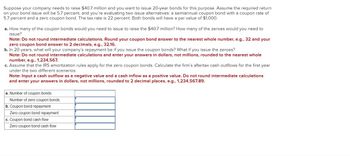
Essentials Of Investments
11th Edition
ISBN: 9781260013924
Author: Bodie, Zvi, Kane, Alex, MARCUS, Alan J.
Publisher: Mcgraw-hill Education,
expand_more
expand_more
format_list_bulleted
Question
Baghiben

Transcribed Image Text:Suppose your company needs to raise $40.7 million and you want to issue 20-year bonds for this purpose. Assume the required return
on your bond issue will be 5.7 percent, and you're evaluating two issue alternatives: a semiannual coupon bond with a coupon rate of
5.7 percent and a zero coupon bond. The tax rate is 22 percent. Both bonds will have a par value of $1,000.
a. How many of the coupon bonds would you need to issue to raise the $40.7 million? How many of the zeroes would you need to
issue?
Note: Do not round intermediate calculations. Round your coupon bond answer to the nearest whole number, e.g., 32 and your
zero coupon bond answer to 2 decimals, e.g., 32.16.
b. In 20 years, what will your company's repayment
if you issue the coupon bonds? What if you issue the zeroes?
Note: Do not round intermediate calculations and enter your answers in dollars, not millions, rounded to the nearest whole
number, e.g., 1,234,567.
c. Assume that the IRS amortization rules apply for the zero coupon bonds. Calculate the firm's aftertax cash outflows for the first year
under the two different scenarios.
Note: Input a cash outflow as a negative value and a cash inflow as a positive value. Do not round intermediate calculations
and enter your answers in dollars, not millions, rounded to 2 decimal places, e.g., 1,234,567.89.
a. Number of coupon bonds
Number of zero coupon bonds
b. Coupon bond repayment
Zero coupon bond repayment
c. Coupon bond cash flow
Zero coupon bond cash flow
Expert Solution
This question has been solved!
Explore an expertly crafted, step-by-step solution for a thorough understanding of key concepts.
Step by stepSolved in 3 steps with 2 images

Knowledge Booster
Learn more about
Need a deep-dive on the concept behind this application? Look no further. Learn more about this topic, finance and related others by exploring similar questions and additional content below.Similar questions
Recommended textbooks for you
 Essentials Of InvestmentsFinanceISBN:9781260013924Author:Bodie, Zvi, Kane, Alex, MARCUS, Alan J.Publisher:Mcgraw-hill Education,
Essentials Of InvestmentsFinanceISBN:9781260013924Author:Bodie, Zvi, Kane, Alex, MARCUS, Alan J.Publisher:Mcgraw-hill Education,

 Foundations Of FinanceFinanceISBN:9780134897264Author:KEOWN, Arthur J., Martin, John D., PETTY, J. WilliamPublisher:Pearson,
Foundations Of FinanceFinanceISBN:9780134897264Author:KEOWN, Arthur J., Martin, John D., PETTY, J. WilliamPublisher:Pearson, Fundamentals of Financial Management (MindTap Cou...FinanceISBN:9781337395250Author:Eugene F. Brigham, Joel F. HoustonPublisher:Cengage Learning
Fundamentals of Financial Management (MindTap Cou...FinanceISBN:9781337395250Author:Eugene F. Brigham, Joel F. HoustonPublisher:Cengage Learning Corporate Finance (The Mcgraw-hill/Irwin Series i...FinanceISBN:9780077861759Author:Stephen A. Ross Franco Modigliani Professor of Financial Economics Professor, Randolph W Westerfield Robert R. Dockson Deans Chair in Bus. Admin., Jeffrey Jaffe, Bradford D Jordan ProfessorPublisher:McGraw-Hill Education
Corporate Finance (The Mcgraw-hill/Irwin Series i...FinanceISBN:9780077861759Author:Stephen A. Ross Franco Modigliani Professor of Financial Economics Professor, Randolph W Westerfield Robert R. Dockson Deans Chair in Bus. Admin., Jeffrey Jaffe, Bradford D Jordan ProfessorPublisher:McGraw-Hill Education

Essentials Of Investments
Finance
ISBN:9781260013924
Author:Bodie, Zvi, Kane, Alex, MARCUS, Alan J.
Publisher:Mcgraw-hill Education,



Foundations Of Finance
Finance
ISBN:9780134897264
Author:KEOWN, Arthur J., Martin, John D., PETTY, J. William
Publisher:Pearson,

Fundamentals of Financial Management (MindTap Cou...
Finance
ISBN:9781337395250
Author:Eugene F. Brigham, Joel F. Houston
Publisher:Cengage Learning

Corporate Finance (The Mcgraw-hill/Irwin Series i...
Finance
ISBN:9780077861759
Author:Stephen A. Ross Franco Modigliani Professor of Financial Economics Professor, Randolph W Westerfield Robert R. Dockson Deans Chair in Bus. Admin., Jeffrey Jaffe, Bradford D Jordan Professor
Publisher:McGraw-Hill Education